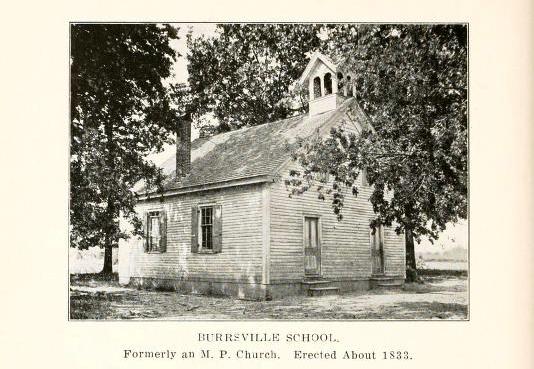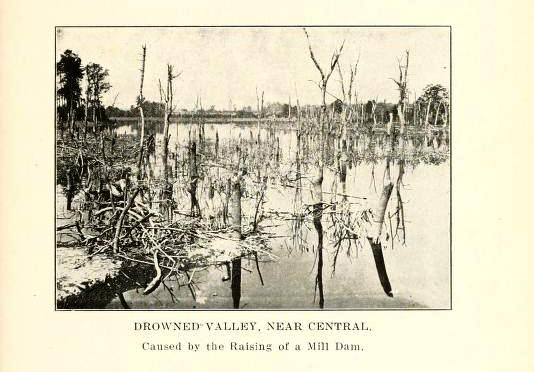The History of Caroline County, Maryland, From Its Beginning
Burrsville (Punch Hall, Union Corner), Central, Camp Grove

Two very different stories are in circulation in regard to the origin of the name Punch Hall. One authority tells us that the name originated from the fact that runaway slaves hid under a building called a hall standing on what is known as the F. C. Porter lot. To capture these fugitives the citizens used long poles to punch them out. Thus came the name Punch Hall. Other authorities claim that the name Punch Hall originated from a citizen by the name of Hall living in that end of the town who kept the inn and sold strong drink.
The name of Burrsville was probably selected for the post office with reference to any suggestions in the neighborhood. Be this as it may, we know that Union Corner was a little hamlet, long years ago, while the central group of buildings was designated as Punch Hall.
The first public school for this section seems to have been Chinquapin, provision for which was made by the Legislature about 1840. This building stood on the Saulsbury land about one mile west from the village on the Denton road and continued as the school for the neighborhood until sometime in the seventies when it was discontinued and a school building erected on the spot now occupied by the Union. M. P. Church. This was Burrsville's first public school and the building thereof by private means was prompted doubtless for fear the colored people after the passage of the Fifteenth Amendment would be allowed the privilege of attending school with the white at Chinquapin.
In eighteen hundred and eighty-four this building was moved about a mile west of the village to a corner of the county farm where it has since been used as a colored school. The old M. P. Church, erected in 1833 or 1834, was purchased by the county and is still used as the public school building for Burrsville. Thus this village has the honor of having its school housed in one of the oldest frame buildings in the county, perhaps, in the state.
At the time the church was purchased for the school, the school lot was sold or traded to the church trustees for a church site as indicated above.
WESLEY M. E. CHURCH
The following is taken from a note book kept in eighteen hundred thirty-three by Thomas Baynard:
"A record of the proceedings of the trustees legally appointed in the year of our Lord one thousand eight hundred and thirty three for the Methodist Episcopal Church near Burrsville which church is not yet built but is in contemplation and to supply the place of the old church near the said village which is now in a condition not fit for worship."The said church which was completed in eighteen thirty-five, was name Wesleyan Chapel and dedicated December twenty-fifth of the same year.
The site for this church was purchased from Reuben R. Richardson of Burrsville and was located between Burrsville and the present M. E. Church. This building served as a place of worship until eighteen seventy-two, when it was sold to John Cahall, a son of Archibald Cahall, who was one of the building committee of eighteen thirty-three, and is now used as a barn on the Cahall farm.
The present M. E. Church is known as Wesley's Chapel and was erected in eighteen seventy-two on a corner of the Cahall farm. It is said that Thomas Melvin, one of the founders of the Methodist Protestant Church, then living near Burrsville did about 1834 deed a piece of land to be used as a site for an M. P. Church to be erected. The church that was built about this time is in the main the same structure that has been used as the public school since 1884.
From Burrsville neighborhood have gone out some men of state and national fame. Among them are the Saulsbury brothers who attended Chinquapin school and in young manhood moved to Delaware. One of them, Gove by name, became a prominent physician of Dover, and later governor of the state. Another brother, Willard, became Chief Justice of the state and a third one, Eli, served as United States Senator from Delaware for nearly a generation. The Melvin family from which sprang several important men who have filled honored places in the Maryland Annual Conference of the M. P. Church was prominent here years ago. Among them are Walter Graham, D. D., and T. H. Lewis, D. D., President of Western Maryland College, also three Melvin brothers who served with honor in the ministerial ranks. Still later we have Dr. M. Bates Stephens, State Superintendent of Public Schools.
Contributed by MARY E. RAUGHLEY
CENTRAL
A sketch-An Old Time Maryland School-in this volume describes the school
at Townsend's Cross-Roads which was the forerunner of the famous
Chinquapin school erected on the road to Burrsville in about 1840.
After this old building (Chinquapin)
had stood about fifty years there were a good many people moving in
around Towson's Cross Roads. These people thought it was too far
to send their children to this school, hence they wanted a new building.
John R. Wyatt gave one acre of
wood lot on the North West side of his farm for their school building.
The timber was cut and the building erected in 1879. After it was
completed they decided to call it the Wyatt's school in honor of Mr.
Wyatt.
A few years later the Methodist
Church was built by the side of the school. The people in the
community decided to name it Central it being about central of the
community and midway between Burrsville and Denton. The school has
since been known as Central.

CAMP GROVE (Chilton's)
The first school for this section was organized many years ago, because
legislature records indicate that provision was made in 1830 to move
from the present Sheppard's church site a school building, to the south
end of Carter's or White's Lane, hence the name Carter's which was
applied to the school for many years afterwards.
One reason, of course, for this early
school was the fact that several prominent men lived in this community
in Revolutionary War times. Among them may be mentioned Col.
Matthew Driver, who built and lived in what is the Brick House on
the Horsey farm. A complete description of this man and his home
is given elsewhere in this book. Thomas White,
another large land owner, lived on what is now the Carter land.
Between the camp ground and Burrsville was the Fountain estate. Of
this family Andrew Fountain was a
captain of militia in the Revolution, while Marcy
Fountain becam a prominent citizen of the upper section
of the country.
At this time or a little later, William
Chilton possessed the land around the camp ground and
former mill site and erected at the head of Chapel Branch a mill which
continued for many years. Upon the school's being located on his
land, or a lot thereform, it was given the name of Chilton's, which is
use by many at present, though the official name is Camp Grove.
Two school buildings have been burned
on the site of the present one which was erected in 1918 through the
cooperative efforts of a few enterprising residents of the community.
Camp Grove School takes its name from
being on a part of the old Chilton's camp ground. For many years
this grove was annually tented, and religious services held under the
auspice of the Methodist Protestant denomination. Along with
improvement in travel and other changes in events, the camp, in the
main, has ceased to function as in olden times, and is rapidly
disappearing.